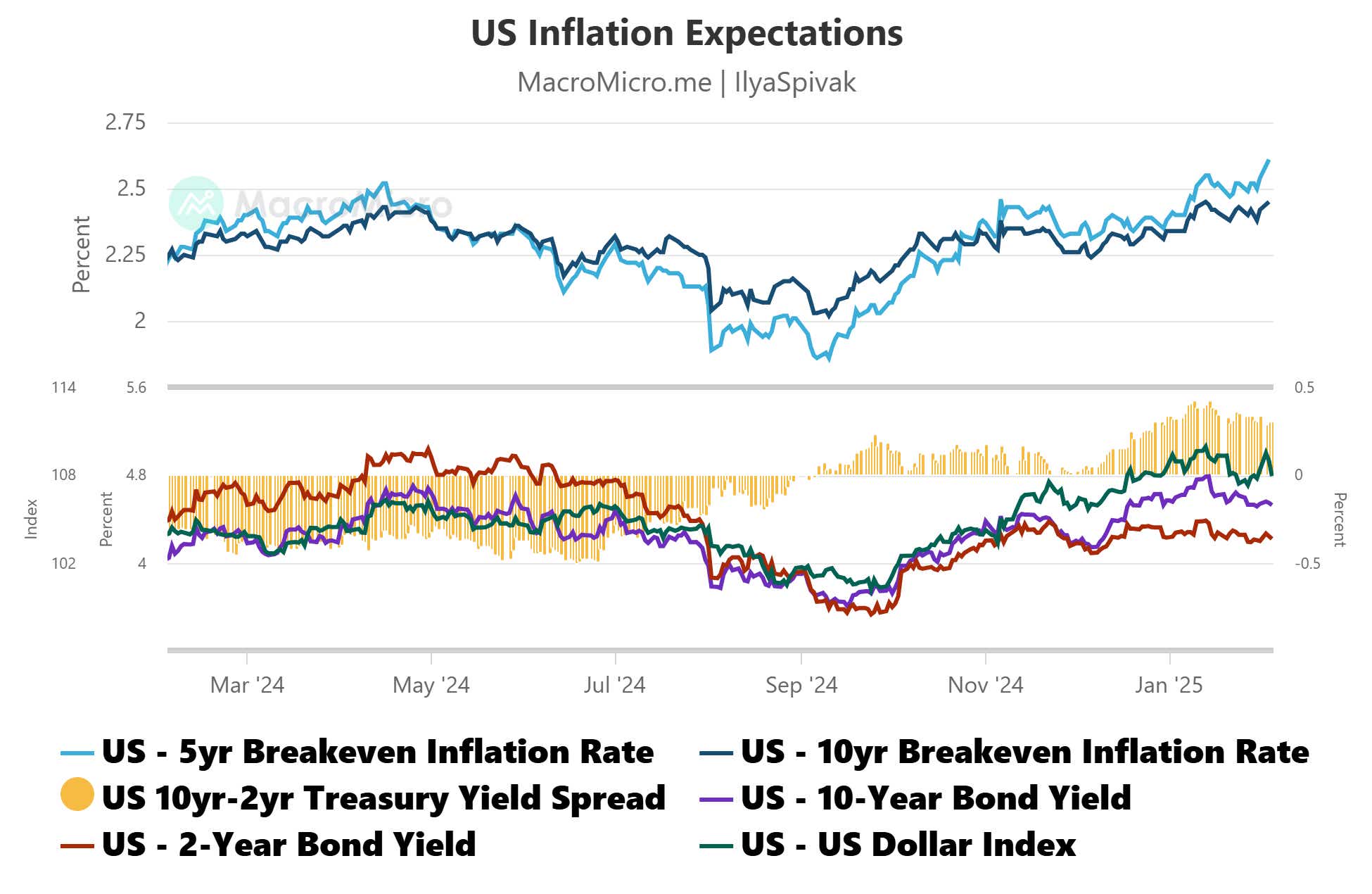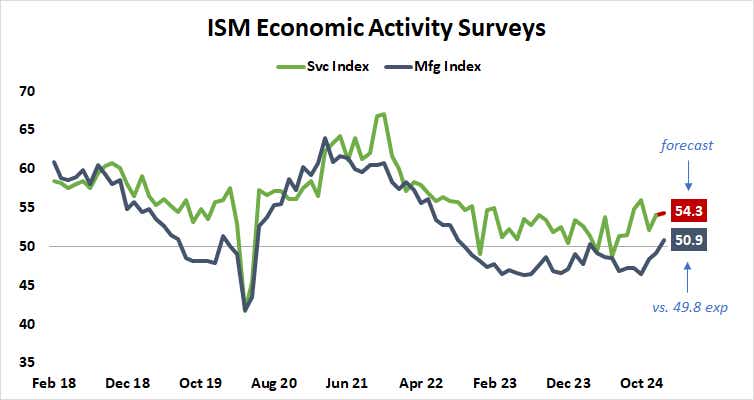Trump Tariff Drama Leaves Stocks Uneasy Before Key U.S. Economic Data

Trump Tariff Drama Leaves Stocks Uneasy Before Key U.S. Economic Data
By:Ilya Spivak
The markets still cannot relax after whipsaw decisions on import duties
- The trump tariff U-turn may translate into a tailwind for the bond market.
- Stock markets seem unsteady as key U.S. economic data looms.
- A firm ISM services report may cool Fed rate cut bets and dull investors’ appetite for risk.
Wall Street seems to be struggling with what to make of the “here today, gone tomorrow” trade war drama that gripped investors at the start of the trading week. President Trump levied tariffs on China, Canada and Mexico over the weekend. The North American portion of the plan was put on pause within a day of the news.
Stock markets lurched sharply lower at the weekly trading open following the tariffs’ arrival, and the U.S. dollar soared against most of its major peers. These moves began to reverse after Mexican President Claudia Sheinbaum struck a deal with Trump. They have been entirely erased now that Canada’s Prime Minister Justin Trudeau has done the same.
Trump tariff drama may help the bond market …
The episode seems to offer a preliminary answer to one of investors’ most pressing questions in the wake of Trump’s election victory in November: Does the new administration see higher tariffs as a goal of economic policy onto itself, or will levies amount to leverage in negotiations? The latter now seems more likely.

Markets may have realized as much, and that would help explain the rise in U.S. Treasury bonds on the day after the whipsaw. Investors have long judged that Trump’s return may fuel inflation, in part because the tariffs he favored would amount to a consumption tax on imports and boost prices. This helped cool Fed rate cut bets and lift yields.
Now that the threat of tariffs appears to be meant as an inducement and may not materialize in earnest, repricing inflation expectations somewhat lower seems to follow. That understandably amounts to a tailwind of bond prices. For their part, stocks might have been expected to embrace the parallel decline in borrowing costs.
... but stocks are uneasy as U.S. economic data looms
That part of the equation is yet to materialize. The bellwether S&P 500 is a case in point. The index just managed to fill in the downward gap at the weekly trading open, but no more. On net, it is trading less than 0.1% removed from last week’s close. A similar setup appears in the Nasdaq 100, the Russell 2000 and the Dow Jones Industrial Average.

Such caution may be rewarded as economic data warns of an ongoing inflationary threat, tariffs or not. A survey from the Institute of Supply Management (ISM) is set to show the U.S. service sector expanded at a solid pace in January. Price growth will be in focus after it quickened to the fastest in almost two years in December.
The companion ISM manufacturing survey revealed a brisk pick up on this front: prices grew at the fastest rate since May. That came alongside an unexpected expansion in overall activity growth as new orders and employment gathered steam. Similar buoyancy on the services side may send Treasury yields and the U.S. dollar higher once again.
Ilya Spivak, tastylive head of global macro, has 15 years of experience in trading strategy, and he specializes in identifying thematic moves in currencies, commodities, interest rates and equities. He hosts Macro Money and co-hosts Overtime, Monday-Thursday. @Ilyaspivak
For live daily programming, market news and commentary, visit tastylive or the YouTube channels tastylive (for options traders), and tastyliveTrending for stocks, futures, forex & macro.
Trade with a better broker, open a tastytrade account today. tastylive, Inc. and tastytrade, Inc. are separate but affiliated companies.
Options involve risk and are not suitable for all investors. Please read Characteristics and Risks of Standardized Options before deciding to invest in options.
tastylive content is created, produced, and provided solely by tastylive, Inc. (“tastylive”) and is for informational and educational purposes only. It is not, nor is it intended to be, trading or investment advice or a recommendation that any security, futures contract, digital asset, other product, transaction, or investment strategy is suitable for any person. Trading securities, futures products, and digital assets involve risk and may result in a loss greater than the original amount invested. tastylive, through its content, financial programming or otherwise, does not provide investment or financial advice or make investment recommendations. Investment information provided may not be appropriate for all investors and is provided without respect to individual investor financial sophistication, financial situation, investing time horizon or risk tolerance. tastylive is not in the business of transacting securities trades, nor does it direct client commodity accounts or give commodity trading advice tailored to any particular client’s situation or investment objectives. Supporting documentation for any claims (including claims made on behalf of options programs), comparisons, statistics, or other technical data, if applicable, will be supplied upon request. tastylive is not a licensed financial adviser, registered investment adviser, or a registered broker-dealer. Options, futures, and futures options are not suitable for all investors. Prior to trading securities, options, futures, or futures options, please read the applicable risk disclosures, including, but not limited to, the Characteristics and Risks of Standardized Options Disclosure and the Futures and Exchange-Traded Options Risk Disclosure found on tastytrade.com/disclosures.
tastytrade, Inc. ("tastytrade”) is a registered broker-dealer and member of FINRA, NFA, and SIPC. tastytrade was previously known as tastyworks, Inc. (“tastyworks”). tastytrade offers self-directed brokerage accounts to its customers. tastytrade does not give financial or trading advice, nor does it make investment recommendations. You alone are responsible for making your investment and trading decisions and for evaluating the merits and risks associated with the use of tastytrade’s systems, services or products. tastytrade is a wholly-owned subsidiary of tastylive, Inc.
tastytrade has entered into a Marketing Agreement with tastylive (“Marketing Agent”) whereby tastytrade pays compensation to Marketing Agent to recommend tastytrade’s brokerage services. The existence of this Marketing Agreement should not be deemed as an endorsement or recommendation of Marketing Agent by tastytrade. tastytrade and Marketing Agent are separate entities with their own products and services. tastylive is the parent company of tastytrade.
tastyfx, LLC (“tastyfx”) is a Commodity Futures Trading Commission (“CFTC”) registered Retail Foreign Exchange Dealer (RFED) and Introducing Broker (IB) and Forex Dealer Member (FDM) of the National Futures Association (“NFA”) (NFA ID 0509630). Leveraged trading in foreign currency or off-exchange products on margin carries significant risk and may not be suitable for all investors. We advise you to carefully consider whether trading is appropriate for you based on your personal circumstances as you may lose more than you invest.
tastycrypto is provided solely by tasty Software Solutions, LLC. tasty Software Solutions, LLC is a separate but affiliate company of tastylive, Inc. Neither tastylive nor any of its affiliates are responsible for the products or services provided by tasty Software Solutions, LLC. Cryptocurrency trading is not suitable for all investors due to the number of risks involved. The value of any cryptocurrency, including digital assets pegged to fiat currency, commodities, or any other asset, may go to zero.
© copyright 2013 - 2025 tastylive, Inc. All Rights Reserved. Applicable portions of the Terms of Use on tastylive.com apply. Reproduction, adaptation, distribution, public display, exhibition for profit, or storage in any electronic storage media in whole or in part is prohibited under penalty of law, provided that you may download tastylive’s podcasts as necessary to view for personal use. tastylive was previously known as tastytrade, Inc. tastylive is a trademark/servicemark owned by tastylive, Inc.